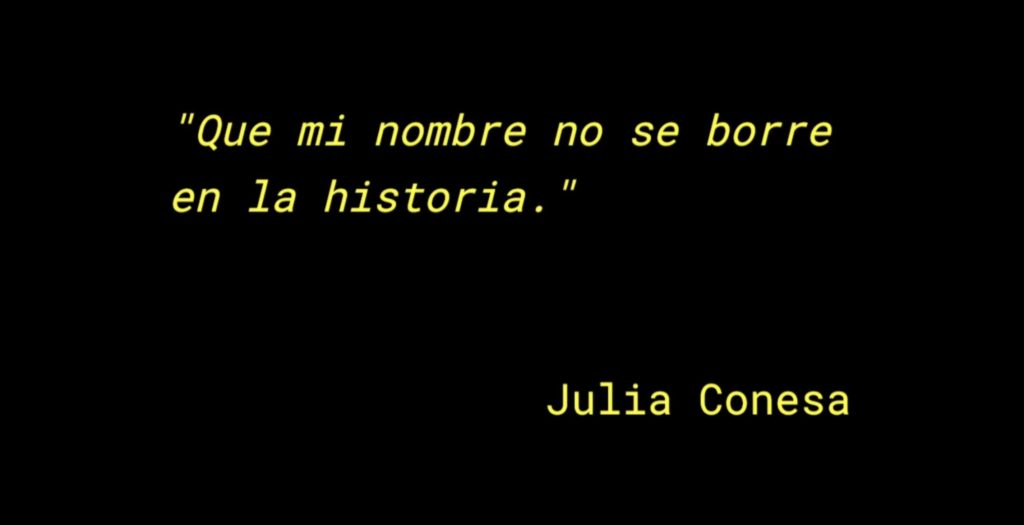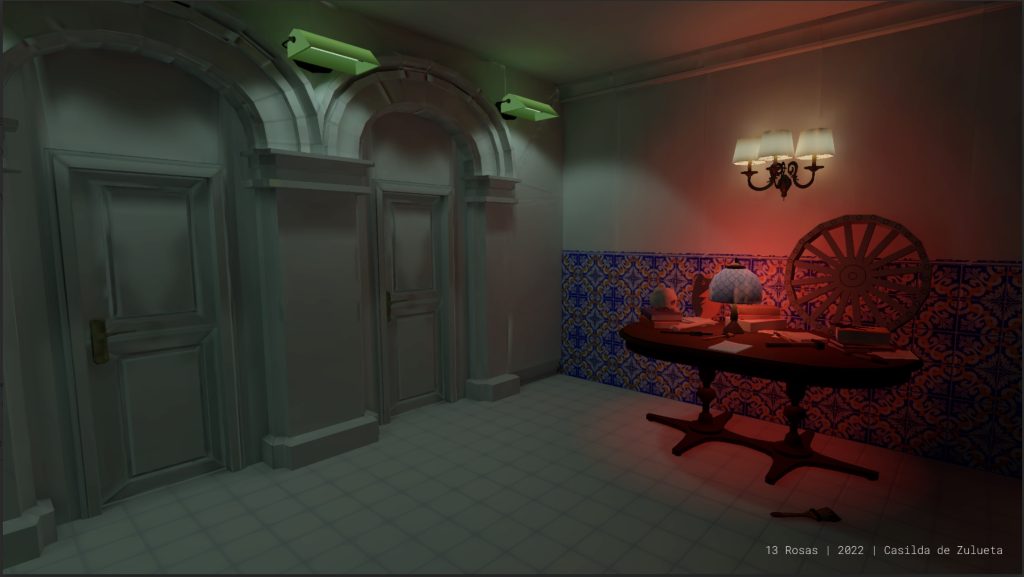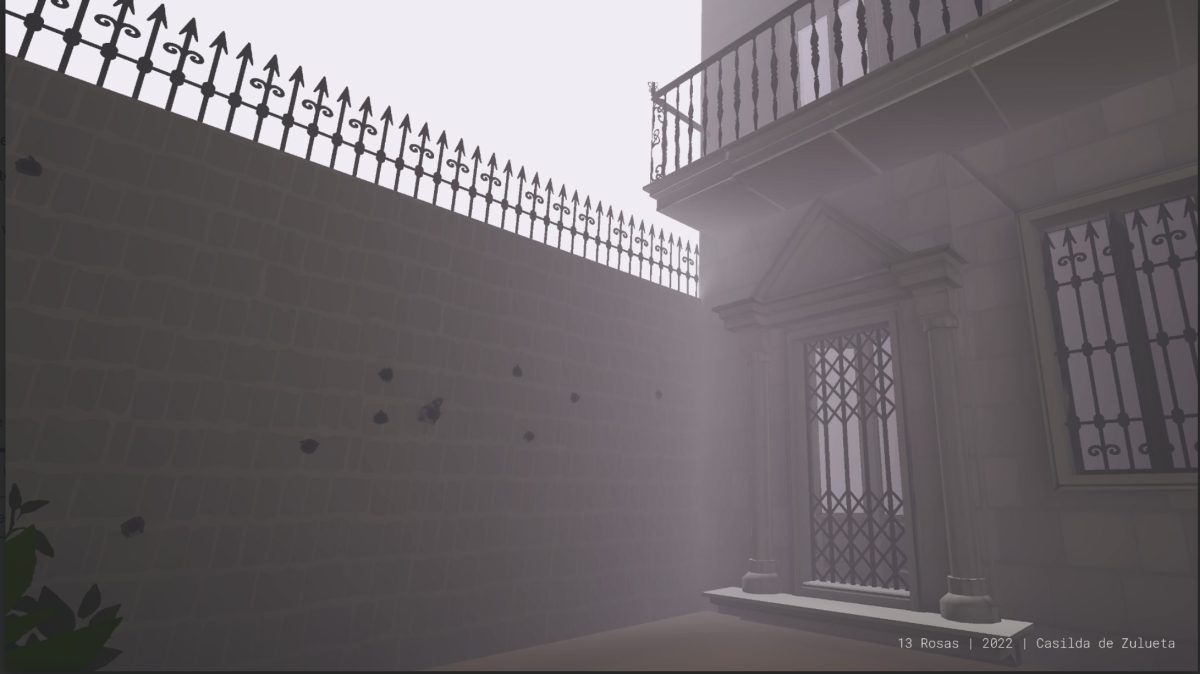13 Rosas is a horror adventure game currently under development about the characteristics and mechanisms of fascism in general and the Spanish Civil War (1936-1939) in particular. Albeit its necessary incursions with historiography (in the sense of methodologically retelling and contextualizing the past), the game relies on fictionalizing the player actions (you are not a historical character changing history as you progress) and depicting and symbolizing historical and ideological subjects. As in many horror stories, there is a monster, and that monster is fascism.
The game is designed for mobile devices. A playable demo for Android is currently available in five languages on itch.io. Players must explore a nightmarish, impossible building to retrieve thirteen red roses for a monster guarding the exit gate that resembles Pablo Picasso’s most iconic painting Guernica (1937). At its current state, only three roses can be found, which lie behind puzzles and riddles inspired by philosophical texts like Umberto Eco’s 14 definitions of ur-fascism.1 The puzzles are referencing pivotal events of horror during the war (La Desbandá,2 the bombing of Alacant’s central market3) and paying tribute to the resistance (the International Brigades,4 las Misiones Pedagógicas5). The remaining ten roses are given automatically to the player once the other three have been acquired.
The title and leading thread of the game corresponds to the given name of a group of women members of the Unified Socialist Youth (Juventudes Socialistas Unificadas) that were executed by the fascists not during but after the war. These women have been characterized substantially in cinema and literature, both as protagonists6 and landmark references in historical fiction.7 In 13 Rosas, these women are represented as literal roses in an attempt to avoid banal or insensitive portrayals of actual people, but it is intended for the full development to add to the understanding of their fate.

Fascism, Spanish style
On July 18th, 1936, the Spanish fascists, orchestrated by general Emilio Mola, attempted a coup with the intention of establishing a military junta that would undo the social advancements of a relatively young Spanish Republic. The uprising resulted into a civil war that would last three years, rendering its leader Francisco Franco victorious and initiating 36 years of his regime until his death.
On an international level, the Spanish fascists got the support of Nazi Germany and Fascist Italy, who used the conflict as a laboratory for testing their aviation weaponry.8 At the advent of the Second World War and with the Non-Intervention Agreement in place, the only official aid to the Republic came from the Soviet Union and Mexico.9 In addition to that, tens of thousands of volunteers from more than 50 nations organized in the International Brigades in support of the Republic.10
The fascists’ particular cruelty was a “sufficient extermination”,11 a planned partial annihilation to perpetuate terror. The casualty rate on the republican side was twice as high as on the side of the fascists.12 These destructive mechanics of oppression continued in the form of death penalties and forced disappearances throughout the entire dictatorship.
Ideologically speaking, the Spanish fascists were at war with the “communist jewish masons”, a mythological conspiracy theory created by conservative forces to explain the loss of the Spanish colonies. The Spanish Republic was seen as a continuation of this development, in which Spain was transformed into a decadent nation by the means of modernization and secularization. What emerged from the end of the war was a state legitimated by the Catholic Church and vice versa, where Franco was “Caudillo por la gracia de Dios”.13
Memory Culture in Spain
The subsequent period after the death of the dictator was institutionally a transition towards oblivion. In October 1977,14 “[…] crimes committed by public officials and law enforcement officers against the exercise of the rights of persons […]”15 were amnestied, rendering any crime or violation of human rights committed before December 15, 1976 unpunishable. It is not until 2003 that Spain is mentioned on the the United Nations’s Annual Report of the Working Group on Enforced or Involuntary Disappearances,16 after the insistence of activist associations on the State’s collaboration with the UN.
While governmental bodies neglected considering reparations to the victims of Spanish Christo-Fascism for the longest time, the grieving families worked towards exhumating their relatives. Organizations like the Asociación por la Recuperación de la Memoria Histórica (ARMH),17 which was founded in 2000 after the exhumation of 13 republican civilians in a mass grave in Priaranza del Bierzo,18 and the Foro por la Memoria Democrática, founded in 2002,19 have dedicated their efforts to the remembrance of a past so close yet so abandoned.
On top of this national amnesia, fascists today still have an important place of pilgrimage standing less than 60 kilometers away from Madrid, which was built with enslaved prisoners for over almost two decades from 1940 to 1958. The Valle de los Caídos, recently renamed to Valle de Cuelgamuros,20 is a memorial “erected to welcome the heroes and martyrs of [their] Crusade”,21 a monstrous monument fancying a pharaonic-esque Christian tomb that housed Franco’s corpse alongside the body of the fascist ideologist and Falange founder Jose Antonio Primo de Rivera. Its touristic attraction has diminished around 70%22 with the recent relocation of the aforementioned in 2019 and earlier this year respectively.
It was only in 2007 that Spanish law extended the rights of those wronged during the Civil War and the dictatorship with the Historical Memory Law (Ley 52/2007).23 Since that year, the ARMH could only cover around 2% of the budget they required for the subsequent exhumations. According to the association, the majority of the remaining 98% has been volunteered by its network of archaeologists, historians, families and neighbors of the victims. In 2022, the new Democratic Memory Law (Ley 20/2022) replaced 52/2007, extending its definition of Franco’s fascism and describing it for the first time as illegal, thus initiating procedures to repurposing the Valle de Cuelgamuros, and amending 1977’s amnesty to finally adhere to international law.
Lastly, there is a particular bravado inherent to the Spanish conservatives. Remembering means challenging their source of nobility, of their wealth and positions of power. Their lack of compliance ranges from mocking the exhumation efforts,24 to halting remembrance projects,25 restoring street names to prominent Francoists and fascist movements26 or blurring the language with which they show rendition.27
With regard to the various cultural industries available within the country, remembering the Civil War and Franco’s dictatorship in the times of democracy has been ostensibly exploited from historical fiction to documentaries,28 history books (generalist and thematized),29 and even as a backdrop for an idiosyncratic way of telling fantasy stories,30 perhaps to compensate for the institutional silence brought by the Transición until these days. The quality, accuracy or unselfishness of this generous body of work is a discussion for another day, but it is important to emphasize the contrasting lack of video games of the same nature.31

Developing 13 Rosas as a Virtual Memorial (for the lack of physical ones)
13 Rosas is a horror game on the terrors of fascism. Since its ideation, it was clear that it would not be developed with the intention of substituting a sensible educational program and the much needed institutional restoration and remembrance policies. Much like many self-initiated game projects, the idea came out of a quite playful conceptualization: what if Slenderman32 but instead of 8 pages you had to find 13 roses?
The game mechanics and audiovisual aesthetics take direct inspiration from early survival horror series like Silent Hill,33 but there were more modern iterations on horror from the indie and amateur development scene that inspired the feasibility and scope of this game, like the ones by Chilla’s Art,34 Kitty Horrorshow,35 the SCP Foundation adaptations36 and the aforementioned Slenderman. A secondary goal was to design the game mobile-first, so it could reach demographics beyond the console or gaming PC owners.
In principle, it was fitting to encapsulate this topic in a genre where the feeling of powerlessness and dread, metaphorical abstractions of uncomfortable aspects of individual and social problems and the on occasion cathartic outcomes are to be expected. In contrast with other video game genres, killing enemies is not an ubiquitous affordance for the player (although it might be possible to die), and that was something worth exploring too.
A few months before the 13 Rosas demo was released, another indie horror game got published: ROJO: A Spanish Horror Experience,37 where one can go into an old fascist’s home, fictionally placed in the richest neighborhood of Madrid, looking for the player character’s disappeared friend. This “haunted house” is fully decorated with fascist ornaments, giving a detailed depiction of the collective understanding of Francoist nostalgia. In contrast with ROJO, 13 Rosas’s iconographic level is a homage to the symbols of the Second Republic and at this point there are no game assets with fascist paraphernalia to avoid potential reappropriations and fetishizations.
The assumption was that if the development deviated from its oneiric conception and was designed as a non-fictional interactive, it would become dry and unplayable, but it was thought pertinent to focus the discourse around the game on its remembrance potential, its rigorousness and discretion. The game story is set on a moment distant from the periods it addresses. The subjects are only memories recalled in the form of texts, photographs and icons. All allusions to real-life events are based on official documentation. The compromise with the past remains.
Casilda de Zulueta (Twitter; Bluesky) is a freelancer technical artist and animator, indie developer and animation teacher. With 8 years in the profession, she likes to optimize graphics for low-end devices, takes pride in making game assets run smoothly without sacrificing visual quality, and will animate whatever may fall into her hands. Native from Valencia, one of the three capitals of the Second Spanish Republic, she moved to Germany to obtain a master’s degree in Game Development & Research (M.A.) at the Cologne Game Lab with the intention of making games not only for a living, but as a means of creative expression. It is during that time when she made the first iteration of “13 Rosas”, a historical horror adventure game for mobile about the Spanish Civil War (1936-1939).
Notes
- Umberto Eco, “Ur-Fascism” The New York Review of Books, June 22nd, 1995. https://www.nybooks.com/articles/1995/06/22/ur-fascism/. ↩︎
- Norman Bethune, La desbandá: el crimen de la carretera de Málaga a Almería y otros escritos. Pepitas 64/289. Logroño: Pepitas de Calabaza, 2022. ↩︎
- www.elsaltodiario.com, “La masacre del mercado de Alacant”, Accessed November 5th, 2023. https://www.elsaltodiario.com/memoria-historica/masacre-mercado-de-alacant. ↩︎
- Paul Preston, A Concise History of the Spanish Civil War, Rev. ed. London: Harper Collins, 1996. ↩︎
- Francisco Canes Garrido, “Las misiones pedagógicas: educación y tiempo libre en la Segunda República”, Revista complutense de educación 4, núm. 1 (1993): 147-68. https://dialnet.unirioja.es/servlet/articulo?codigo=150110. ↩︎
- José María Almela and Veronica Vigil, dir. Que mi nombre no se borre de la historia. 2006; Spain: Delta Films Media Work; Emilio Martínez Lázaro, dir. Las 13 rosas. 2007; Spain: Enrique Cerezo PC and Pedro Costa PC. ↩︎
- Dulce Chacón. La voz dormida. Madrid: Alfaguara, 2002. ↩︎
- La Vanguardia. “La aviación: una nueva amenaza en la Guerra Civil española”, April 19th, 2017. https://www.lavanguardia.com/historiayvida/historia-contemporanea/20170209/47312998434/la-aviacion-una-nueva-amenaza-en-la-guerra-civil-espanola.html. ↩︎
- “Qué papel tuvo México en la Guerra Civil española”, BBC News Mundo, Accessed November 5th, 2023. https://www.bbc.com/mundo/noticias-america-latina-47757978. ↩︎
- Preston, A Concise History of the Spanish Civil War. ↩︎
- Francisco Moreno Gómez, Los desaparecidos de Franco: un estudio factual y teórico en el contexto de los crímenes internacionales y las comisiones de la verdad. Madrid: Alpuerto, 2016. ↩︎
- José Manuel Abad Liñán, “¿Cuántas víctimas se cobró la Guerra Civil? ¿Dónde hubo más?”, El País, February 28th, 2019, sec. Sepa Usted. https://elpais.com/politica/2019/02/11/sepa_usted/1549896518_673788.html. ↩︎
- Giuliana Di Febo, Ritos de guerra y de victoria en la España franquista. Palimpsesto: Memoria del cristianismo, memoria humana 15. Bilbao: Desclée de Brouwer, 2002. ↩︎
- “BOE-A-1977-24937 Ley 46/1977, de 15 de octubre, de Amnistía.” Accessed November 5th, 2023. https://www.boe.es/buscar/act.php?id=BOE-A-1977-24937#asegundo. ↩︎
- Translated from the original from the previous reference: “Los delitos cometidos por los funcionarios y agentes del orden público contra el ejercicio de los derechos de las personas.” ↩︎
- “E/CN.4/2004/58”. Accessed November 5th, 2023. https://undocs.org/Home/Mobile?FinalSymbol=E%2FCN.4%2F2004%2F58&Language=E&DeviceType=Mobile&LangRequested=False. ↩︎
- “¿QUÉ ES LA ASOCIACIÓN PARA LA RECUPERACIÓN DE LA MEMORIA HISTÓRICA (ARMH)? | Asociación para la Recuperación de la Memoria Histórica”. Accessed November 5th, 2023. https://memoriahistorica.org.es/que-es-la-asociacion-para-la-recuperacion-de-la-memoria-historica-armh-2000-2012/. ↩︎
- Unesco. “Fosa de Priaranza del Bierzo”. CIPDH – UNESCO (blog). Accessed November 5th, 2023. https://www.cipdh.gob.ar/memorias-situadas/lugar-de-memoria/fosa-de-priaranza-del-bierzo/. ↩︎
- “Qué es el Foro | Memoria Democrática”. Accessed November 5th, 2023. https://memoriademocratica.es/el-foro/. ↩︎
- Marta Borraz, “La ilegalidad de la dictadura o renombrar el Valle de los Caídos: las claves de la nueva ley de memoria democrática”, elDiario.es, July 14th, 2022. https://www.eldiario.es/sociedad/ilegalidad-dictadura-renombrar-valle-caidos-claves-nueva-ley-memoria-democratica_1_9170193.html. ↩︎
- Francisco Franco, “Los restos de José Antonio reposarán en el Valle de los Caídos. Carta del Caudillo a los hermanos de José Antonio,” Pueblo: Diario del Trabajo Nacional: Año XX. Número 6.081. Page 1. March 7th, 1959. Translated from the original: “[…] levantada para acoger a los héroes y mártires de nuestra Cruzada […]”. ↩︎
- ElHuffPost, “Las visitas al Valle de los Caídos bajan casi un 70% desde la exhumación de Franco”, October 26th, 2022. ↩︎
- “Ley de la Memoria Histórica (Ley 52/2007 de 26 de Diciembre)”. Accessed November 5th, 2023. https://www.mpr.gob.es/memoriademocratica/normativa-y-otros-recusos/Paginas/ley-memoria-historica.aspx. ↩︎
- Jorge Sastre, “’Las fosas de no sé quién’ y otras perlas de la hemeroteca de Pablo Casado”, elDiario.es, July 22nd, 2018, https://www.eldiario.es/rastreador/xxi-izquierdas-mejores-pablo-casado_132_2010669.html. ↩︎
- elDiario.es, “La Diputación reclama al alcalde de Sevilla que ‘aclare’ si va a seguir abriendo las fosas comunes del franquismo”, elDiario.es, September 22nd, 2023. https://www.eldiario.es/sevilla/diputacion-reclama-alcalde-sevilla-aclare-si-seguir-abriendo-fosas-comunes-franquismo_1_10533161.html. ↩︎
- elDiario.es, Europa Press, “La Justicia mantiene el nombre Caídos de la División Azul en el callejero de Madrid porque apela al nazismo y no al franquismo”, elDiario.es, May 12th, 2021. https://www.eldiario.es/madrid/justicia-mantiene-calle-caidos-division-azul-callejero-apela-nazismo-no-franquismo_1_7927690.html. ↩︎
- Ritama Muñoz-Rojas, “Almeida, entre homenajes a las víctimas de los nazis y el borrado a las del franquismo.” CTXT, May 25th, 2023. ↩︎
- Almudena Grandes, Las tres bodas de Manolita: el cura de Porlier, el Patronato de Redención de Penas y el nacimiento de la resistencia clandestina contra el franquismo, Madrid, 1940-1950. Episodios de una guerra interminable 3. Barcelona: Tusquets, 2014; Alberto Porlán, dir. Las cajas españolas. 2004; Spain: Drop a Star.. ↩︎
- Paul Preston, The Spanish Holocaust: Inquisition and Extermination in Twentieth-Century Spain. 1. publ. New York: Norton, 2013; Begoña Barrera, La Sección Femenina: 1934-1977: historia de una tutela emocional. Madrid: Alianza Editorial, 2019. ↩︎
- Guillermo Del Toro, dir. El laberinto del fauno. 2006; Spain, Mexico: Tequila Gang, Esperanto Filmoj; Víctor Erice, dir. El espíritu de la colmena. 1973; Spain: Elías Querejeta P.C.; Álex De la Iglesia, dir. Balada triste de trompeta. 2010; Spain: Tornasol Films. ↩︎
- Elena Cortés Alonso, “¿Por qué en España no se hacen videojuegos sobre la Guerra Civil?”, AnaitGames, April 15th, 2021. https://www.anaitgames.com/articulos/videojuegos-guerra-civil-espanola/. ↩︎
- Slender: The Eight Pages. 2012; US: Parsec Productions. ↩︎
- Silent Hill. 1999 / Silent Hill 2. 2001 / Silent Hill 3. 2003 / Silent Hill 4: The Room. 2004; Japan: Team Silent. ↩︎
- Night Delivery | 例外配達. 2021; Japan: Chilla’s Art. ↩︎
- Haunted Cities Volume 2. 2017; NA: Kitty Horrorshow. ↩︎
- The SCP Foundation. “Main – SCP Foundation”. Accessed November 5th, 2023. https://scp-wiki.wikidot.com/. ↩︎
- ROJO: A Spanish Horror Experience. 2022; Spain: Miguel Moreno. ↩︎
